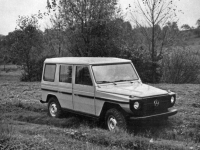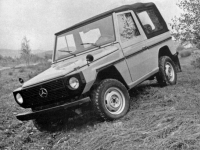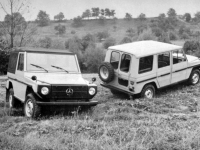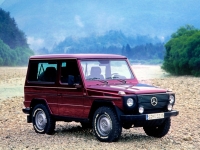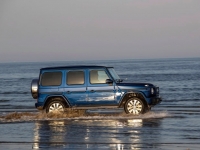Automobiles
40th anniversary of the Mercedes-Benz G-Class
Big birthday for the off-road classic

Series 463 Mercedes-Benz G-Class (Source: © 2019 Daimler AG. All rights reserved.)
USPA NEWS -
The world première of the 460 model series G-model took place between 4 and 9 February 1979 in Toulon, France. On this occasion, the Mercedes-Benz press kit emphasised the values of “ uncompromising off-road and on-road capability“ as well as “maximum variety of use“. These aspects also apply to the new G-Class of the 463 model series that has been built in Graz, Austria, since May 2018. In addition to these elements there is the tradition of performance and unique character. The G-Class has grown into this role over the past decades with ever more success.
Joining forces for the G
The history of the G-model began in the summer of 1969. At the time, Daimler-Benz AG and Austrian Steyr-Daimler-Puch AG entered into talks about a possible cooperation. Both manufacturers offered vehicles with excellent off-road capabilities as part of their product ranges: the Mercedes-Benz Unimog as well as the Puch Haflinger and the Puch Pinzgauer. In 1971, the idea of jointly building an off-road vehicle was fleshed out for the first time. It was to combine extreme off-road capabilities with good handling on the road. Probably as early as in the autumn of 1972, CEOs Dr Joachim Zahn (Daimler-Benz AG) and Dr Karl Rabus (Steyr-Daimler-Puch AG) then came to a basic understanding on jointly developing the light-duty off-road vehicle. The construction team was headed by Erich Ledwinka, Chief Engineer of Steyr-Daimler-Puch.
The history of the G-model began in the summer of 1969. At the time, Daimler-Benz AG and Austrian Steyr-Daimler-Puch AG entered into talks about a possible cooperation. Both manufacturers offered vehicles with excellent off-road capabilities as part of their product ranges: the Mercedes-Benz Unimog as well as the Puch Haflinger and the Puch Pinzgauer. In 1971, the idea of jointly building an off-road vehicle was fleshed out for the first time. It was to combine extreme off-road capabilities with good handling on the road. Probably as early as in the autumn of 1972, CEOs Dr Joachim Zahn (Daimler-Benz AG) and Dr Karl Rabus (Steyr-Daimler-Puch AG) then came to a basic understanding on jointly developing the light-duty off-road vehicle. The construction team was headed by Erich Ledwinka, Chief Engineer of Steyr-Daimler-Puch.
The development then progressed with force. The first wooden model was created by April 1973. The first roadworthy prototype was already being tested in 1974. Photos in the technical description published internally in 1975 showed how quickly the designers and engineers arrived at a design that already came very close to the eventual G. The final styling with the clear profile was defined by Mercedes-Benz Design headed by Bruno Sacco. The stylists masterfully combined the large, smooth surfaces of the vehicle body with the technically defined characteristics such as large approach and departure angles as well as a relatively large vehicle height with a rather small overall width.
The G-model has been built at the Puch plant in Graz-Thondorf from the outset. This plant is also where the new 463 model series G-Class has been assembled since May 2018. Mercedes-Benz has been supplying components including engines, axles, steering systems and large stamped parts from various sites in Germany to Graz since 1979. Series production started in February 1979 shortly after the vehicle´s world première, and Geländefahrzeug Gesellschaft (GfG), founded by the two companies in 1977, was in charge of this process.
The G was initially launched on the market as the 460 model series: a universal off-road vehicle with a comparatively plain interior but a great deal of attention paid to the drivetrain. The selectable standard-fit all-wheel drive with its one hundred per cent interaxle differential lock and optional differential locks on the front and rear axles, which have been standard equipment since 1985, ensure optimum off-road handling characteristics. The frame design and rigid axles with coil springs were aimed at versatility and robustness off the road. The 240 GD and 300 GD models with a diesel engine as well as the 230 G and 280 GE with a petrol engine were available at the production launch. There were two different wheelbases (2,400 and 2,850 millimetres) as well as different body styles (open vehicle, closed station wagon and panel van with closed side walls). In addition to the 460 model series with a 12 V on-board electrical system, Mercedes-Benz offered the 461 model series with a 24 V on-board electrical system for military customers. Its CKD (completely knocked down) version was designated as model series 462.
Success stories
A continuous advancement process for the G-model began shortly after its market launch, which would prove to be the key to its lasting success. Important steps included the standard-fit power steering (first in the 280 GE and 300 GD, from 1987 in all models) and standard-fit differential locks (1985) as well as the introduction of a closed-loop, three-way catalytic converter (from 1986 initially as special equipment in the 230 GE) and the anti-lock braking system (ABS) in model series 463 from 1990. The optimisation of comfort and safety was embodied, among other things, by the standard-fit combination of the most capable vehicle dynamics and all-wheel-drive systems starting in 2001. It comprised the electronically controlled 4ETS traction system, the Electronic Stability Programme ESP® and BAS Brake Assist.
A continuous advancement process for the G-model began shortly after its market launch, which would prove to be the key to its lasting success. Important steps included the standard-fit power steering (first in the 280 GE and 300 GD, from 1987 in all models) and standard-fit differential locks (1985) as well as the introduction of a closed-loop, three-way catalytic converter (from 1986 initially as special equipment in the 230 GE) and the anti-lock braking system (ABS) in model series 463 from 1990. The optimisation of comfort and safety was embodied, among other things, by the standard-fit combination of the most capable vehicle dynamics and all-wheel-drive systems starting in 2001. It comprised the electronically controlled 4ETS traction system, the Electronic Stability Programme ESP® and BAS Brake Assist.
The major facelifts in particular represented important development leaps for the technology of the G. For example, model series 463 was launched in 1990 equipped with permanent instead of the previous on-demand all-wheel drive. Subsequently, eight-cylinder and even twelve-cylinder engines were used in the powerful and luxurious G-Class. At the same time, Mercedes-Benz cultivated the tradition of the G as a versatile utility vehicle. In 1990, this role was initially played by model series 460, before it fell to model series 461, launched in 1992. Today, it is the professional variants of the G-Class which carry these capabilities on into the future.
The tradition of exclusive equipment in the history of the G-Class started with refined details such as individual Recaro seats for driver and front passenger, which were available as special equipment from as early as 1981. The interior was enhanced as standard in 1982. In 1990, model series 463 brought fine-wood applications into the off-road classic that was just eleven years young at the time. This constant change allowed the G-Class to acquire new, private customers. They particularly appreciated the exclusive and powerful variants of the G. A first highlight in this regard was the Mercedes-Benz 500 GE V8, built in small-series production starting in 1993. From 1998, the G 500 then became the standard top-of-the-range model of the Mercedes-Benz G-Class, as the family of off-road vehicles has been known since 1993. The nomenclature of the G thus follows the system established for the other Mercedes-Benz passenger car model series, whereby a letter preceding the three-digit number or a combination of letters designates the class to which the vehicle belongs.
A particularly successful chapter in the history of the G began in 1999: in that year the G 55 AMG became the new top-of-the-range model of model series 463. It formed the basis for the lasting success of the G-Class high-performance vehicles by Mercedes-AMG. Further standards in this regard were set by the G 55 AMG Compressor (2004), the G 63 AMG, the G 65 AMG (both 2012), the G 63 AMG 6x6 (2013) and finally the Mercedes-AMG G 63 of the new G-Class presented in February 2018 (combined fuel consumption: 13.1 l/100 km; combined CO2 emissions: 299 g/km*).
That the G continues to master all challenges successfully in its fourth decade was also demonstrated by other highly exclusive models such as the G 500 4x4² from 2015 and the Mercedes-Maybach G 650 Landaulet from 2017, of which only 99 were made. Both variants of the iconic off-road vehicle opened up new dimensions for the G-Class: the G 500 4x4² with regard to the yet further improved off-road capabilities thanks to portal axles and the Mercedes-Maybach G 650 Landaulet boasting the highest automotive luxury also off the road.
Once again, the G reinvents itself by focusing on important technical details in the new model series 463 G-Class: for example, with the chassis developed jointly by Mercedes-Benz and Mercedes-AMG, featuring a traditional, rigid rear axle and a double-wishbone front axle with independent suspension. What has not changed are the excellent off-road capabilities ““ the new G-Class even surpasses its predecessor in many disciplines. And on the outside, the basic credo is: the genes of the G from 1979 will be evident in any G-Class at first sight.
The new generation of model series 463 celebrated its world première at the North American International Auto Show (NAIAS) in Detroit in January 2018. It transports the strengths of this charismatic performer into a bright future. The first of the models launched is the Mercedes-Benz G 500 (combined fuel consumption: 12.1““11.5 l/100 km; combined CO2 emissions: 276““263 g/km*), followed shortly afterwards by the Mercedes-AMG G 63. In December 2018, the G 350 d (combined fuel consumption: 9.8““9 .6 l/100 km, combined CO2 emissions: 259““2 52 g/km*), the third engine variant featuring the state-of-the-art OM 656 diesel engine, celebrated its world première.
more information: https://www.mercedes-benz.com
Mercedes Review Mercedes G-class G-wagen G Class Amg Mercedes-amg Mercedes G-wagen G63 Amg G-class 2019 Mercedes G-class Review Car Review Doug Demuro Demuro Mercedes Review Suv G Wagon G-wagon G63 Mo Vlogs 2019 Mercedes-benz G-class
Liability for this article lies with the author, who also holds the copyright. Editorial content from USPA may be quoted on other websites as long as the quote comprises no more than 5% of the entire text, is marked as such and the source is named (via hyperlink).


